Spreading over rolling farm country, thick forests, and mountainous terrain, Pennsylvania is a biodiversity hot spot in America, with a staggering array of habitats for Hawks in Pennsylvania along major flight paths. Therefore, this variety is supported by an impressive list of birds, making Pennsylvania a birdwatcher’s haven.
Accipitridae bird-of-prey family members, hawks are excellent with their keen eyesight and acute hearing, and they are very effective predators. Additionally, their feathers usually exhibit subtle similarities between the sexes, although females usually become larger, with slight but apparent dimorphism.
Spotted throughout the world, hawks comprise many species, several of which have been documented in the United States and at least 10 consistently spotted in Pennsylvania. Though uncommon vagrants will sometimes catch birders off guard, the state’s everyday hawks enchant with their power and elegance.
With world-famous protected areas such as Hawk Mountain Sanctuary and top birding spots, Pennsylvania provides unmatched opportunities to see these impressive raptors in their natural habitats. As such, this guide covers 10 hawk species commonly encountered in PA, discussing their habits, habitats, ecological functions, and conservation issues.
“But those who hope in the Lord will renew their strength. They will soar on wings like eagles.” – Isaiah 40:31
Key Takeaways:
- Pennsylvania hosts diverse hawk species, including Red-tailed and Cooper’s Hawks.
- Hawks thrive in forests, fields, and suburban areas across the state.
- They regulate rodent and insect populations, benefiting agriculture and ecosystems.
- Migration events, like Broad-winged Hawk kettles, draw birdwatchers to PA.
- Conservation efforts protect hawks from habitat loss and pollution.
1. Red-tailed Hawk – The Sky’s Dominant Predator:
- Scientific Name: Buteo jamaicensis
- Life Span: 10–20 years
- Size: 18–26 in (45–65 cm)
- Weight: 24–51 oz (690–1460 g)
- Wingspan: 43–57 in (110–145 cm)
- Status: Least Concern
- Diet: Small mammals, birds, reptiles
- Behavior: Solitary, territorial
- Habitat: Open fields, woodlands, highways
In Pennsylvania, the Red-tailed Hawk is a popular predatory bird. Its beautiful reddish-brown tail, which is most vibrant in adults, and broad wings are its most notable features. These hawks may be seen in a variety of locations, including suburban edges and rural farmland. They are often seen soaring in wide, unhurried circles or perched on telephone poles.

They locate mice, voles, rabbits, and even snakes by using their keen eyesight. When hunting, they are very precise and patient. They usually use their powerful talons to dive from high locations in order to capture prey. Farmers value their responsibility to control rodent populations since doing so might protect several crops. Despite the harsh winters, red-tailed hawks may be seen in Pennsylvania throughout the year.
Their presence is indicated by their loud, raspy scream, which is audible across highways and fields. Both birdwatchers and commuters are used to seeing them. They often reuse their nests from year to year and build sturdy platforms out of sticks.
So, They build their nests above rock ledges or in tall trees. They are still among the most common hawks in the state because of their capacity to exist in human-modified settings, such as suburban areas with widely spaced trees.
2. Cooper’s Hawk – The Forest’s Silent Stalker:
- Scientific Name: Accipiter cooperii
- Life Span: 8–12 years
- Size: 14–20 in (35–50 cm)
- Weight: 8–24 oz (220–680 g)
- Wingspan: 24–35 in (62–90 cm)
- Status: Least Concern
- Diet: Small birds, mammals
- Behavior: Agile, secretive
- Habitat: Forests, suburban backyards
Cooper’s Hawks are without a doubt the best at hiding. They can move through Pennsylvania’s deep woods at an amazing pace. Their slender body, short wings, and long, squared-off tails let them move through tight spaces and make quick spins as they hunt for their main food, small birds. For example, they are known to ambush songbirds at backyard feeders, which makes them an exciting but difficult place for suburban birdwatchers to go.
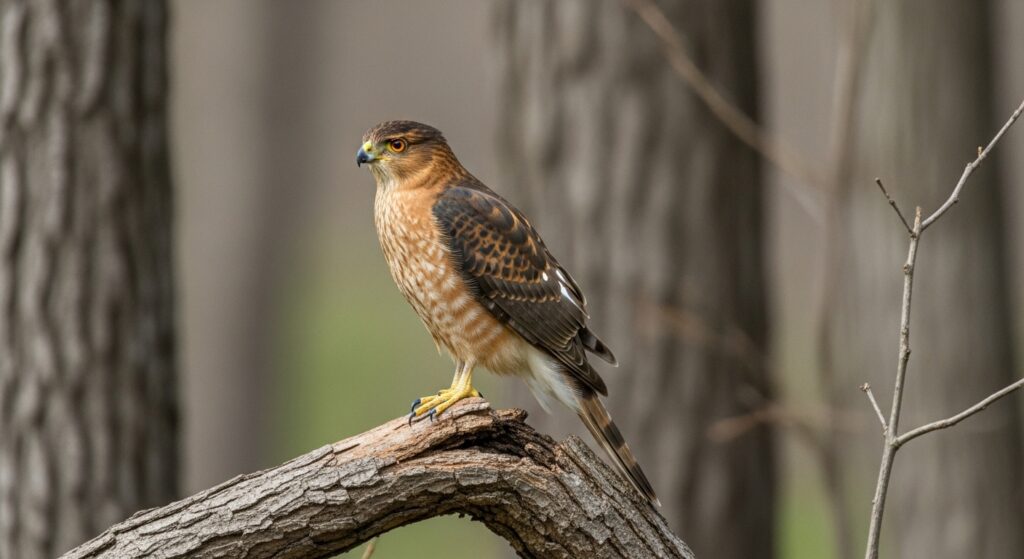
Moreover, Their rust-colored chests and slate-gray backs make them seem even more stealthy as they blend in with the shadows of the forest. The Red-tailed Hawk can fly, but the Cooper’s Hawk relies on surprise and frequently jumps out of concealment to scare its prey. Also, their numbers have gone up because suburban expansion has made wonderful hunting grounds with plenty of feeders and broken-up woodlands.
Coopers are important for keeping the balance of woodland ecosystems by keeping the number of songbirds in check. They frequently make their nests out of sticks and bark behind dense tree canopies, where they can’t be seen. It’s hard to miss them because they fly so quickly, but it’s a real treat for those who are paying attention to see them. John James Audubon remarked, “The hawk’s keen eye sees all, a silent guardian of the forest,” which precisely describes how well they hunt.
“The hawk’s keen eye sees all, a silent guardian of the forest.” – John James Audubon
3. Broad-winged Hawk – The Migratory Spectacle:
- Scientific Name: Buteo platypterus
- Life Span: 12–18 years
- Size: 13–17 in (34–44 cm)
- Weight: 9–20 oz (265–560 g)
- Wingspan: 31–39 in (80–100 cm)
- Status: Least Concern
- Diet: Insects, small mammals, amphibians
- Behavior: Social during migration
- Habitat: Deciduous forests
During Pennsylvania’s fall migration, wide-winged hawks are a common sight. Spiraling up on thermal currents, they form enormous “kettles” of hundreds or thousands of birds. These little hawks, which have short, banded tails and large wings, like to nest beneath dense canopies in the state’s deciduous forests. They consume a wide variety of foods, including amphibians, small mammals, and insects like grasshoppers, which helps manage pest populations.

For instance, they build nests in the forks of large trees during mating season and often add fresh green sprigs to make themselves more comfortable. They begin a long journey to South America in the autumn, soaring hundreds of miles over the hills of Pennsylvania There is. Hawk Mountain Sanctuary where birdwatchers go to see the sight.
Moreover, They provide a particularly impressive airborne spectacle since their behavior during migration differs greatly from that during reproduction. Because broad-winged hawks are very sensitive to losing their habitats, protecting Pennsylvania’s forests is crucial to their ability to reproduce. In the forests, their high-pitched, whistling calls are a silent but distinct sound that alerts anybody who is listening.
More For You: 6 Types of Pink Birds in Alabama (Identification & Photos)!
4. Sharp-shinned Hawk – The Petite Powerhouse:
- Scientific Name: Accipiter striatus
- Life Span: 5–10 years
- Size: 9–13 in (23–34 cm)
- Weight: 3–8 oz (85–220 g)
- Wingspan: 17–23 in (42–58 cm)
- Status: Least Concern
- Diet: Small birds
- Behavior: Fast, elusive
- Habitat: Coniferous forests, suburbs
The Sharp-shinned Hawk is the smallest hawk in Pennsylvania, yet it’s a true beast. Some people think it’s the larger Cooper’s Hawk since its body is slimmer and its tail is shorter and square. These hawks are all about capturing little birds. They may soar across coniferous forests or yards with amazing speed and grace.
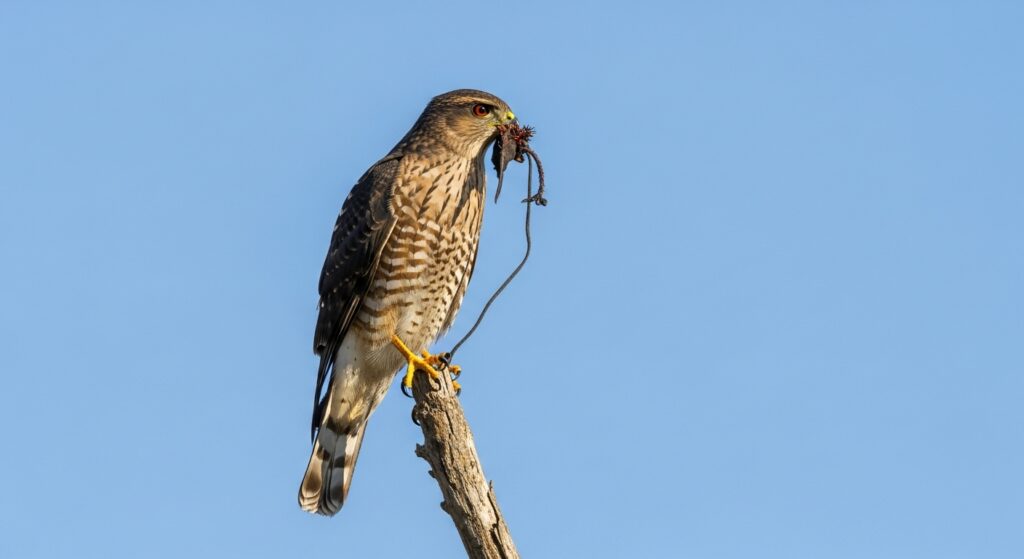
They have small wings and long tails that let them get through dense foliage, which makes them great at hunting sparrows and finches. For example, in the winter, they go to backyard feeders and consume songbirds that aren’t paying attention. Therefore, This could startle those who live there and birdwatchers. Their blue-gray feathers on top and barred feathers on the bottom make them hard to notice, which makes it hard to find them.
Sharp-shinned Hawks build small, snug nests in coniferous trees. They usually utilize nests that they have made before or nests that other birds have made. They are particularly important for keeping the number of birds in control so that less common species don’t take over.
“The hawk, though small, commands the air with unmatched precision.” – Rachel Carson
5. Northern Harrier – The Marshland Glider:
- Scientific Name: Circus hudsonius
- Life Span: 7–12 years
- Size: 18–20 in (41–50 cm)
- Weight: 10–26 oz (290–750 g)
- Wingspan: 38–48 in (97–122 cm)
- Status: Least Concern
- Diet: Small mammals, birds
- Behavior: Low, gliding flight
- Habitat: Marshes, grasslands
A sight to see in Pennsylvania’s marshes are Northern Harriers. They fly like silken moths, gliding low across fields and marshes. They receive sound via their owl-shaped face discs, which are composed of stiff feathers. When sight alone is insufficient, this aids them in locating food sources like voles and mice among dense vegetation. When they tilt and weave, their brilliant white patch on their rumps makes them easy to recognize. In contrast to other hawks, northern harriers primarily depend on their keen hearing.
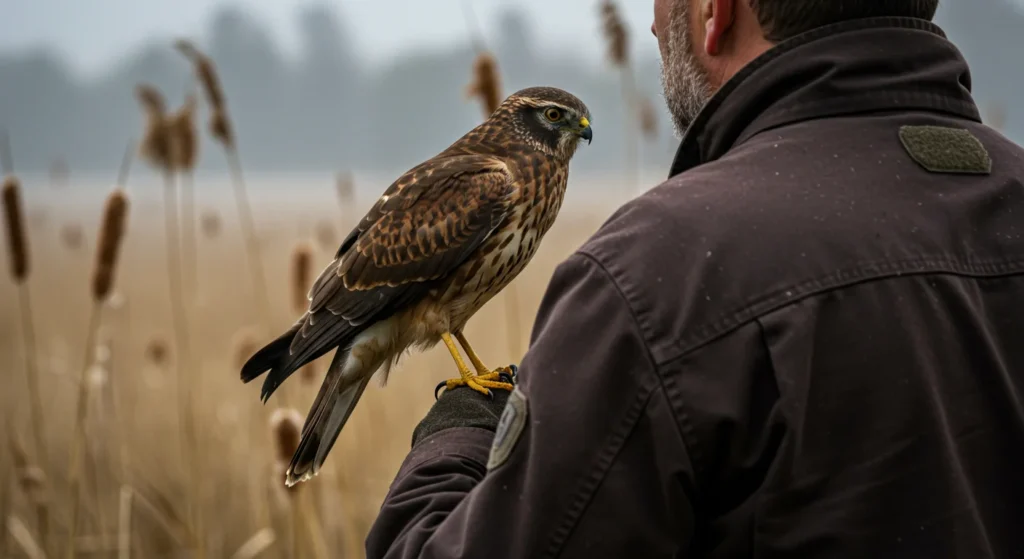
Which is crucial in the world of raptors. They thrive in wetlands with plenty of food, such as those in Pymatuning Reservoir and Erie County. For instance, males do outrageous sky-dancing routines, diving and rolling to attract females during mating season. Their courtship became more dramatic as a result. Because the nests are on the ground and concealed by tall grasses, they are simple to remove.
Therefore, They conserve energy while hunting because of their low, energy-efficient flight, which covers a lot of land. Wetland regions should be protected since development is endangering these vital ecosystems. They hunt differently than other birds, and their elegance is adored by birdwatchers.
More For You: Hawks Spiritual Meaning – Guidance, Power & Purpose!
6. Red-shouldered Hawk – The Woodland Vocalist:
- Scientific Name: Buteo lineatus
- Life Span: 15–20 years
- Size: 16–24ionali
- Weight: 17–27 oz (486–774 g)
- Wingspan: 37–43 in (94–111 cm)
- Status: Least Concern
- Diet: Small mammals, amphibians, reptiles
- Behavior: Vocal, territorial
- Habitat: Riparian forests, swamps
Infilling Pennsylvania’s woodlands with their characteristic calls, Red-shouldered Hawks are a colorful splash. Their rust-red shoulders and boldly banded tails make a dramatic silhouette against the green foliage. These hawks prefer wet woodlands, frequently along streams or swamps, where they hunt frogs, small mammals, and reptiles with accuracy. Their territorial demonstrations, characterized by soaring spirals and swooping dives, indicate their dominance.
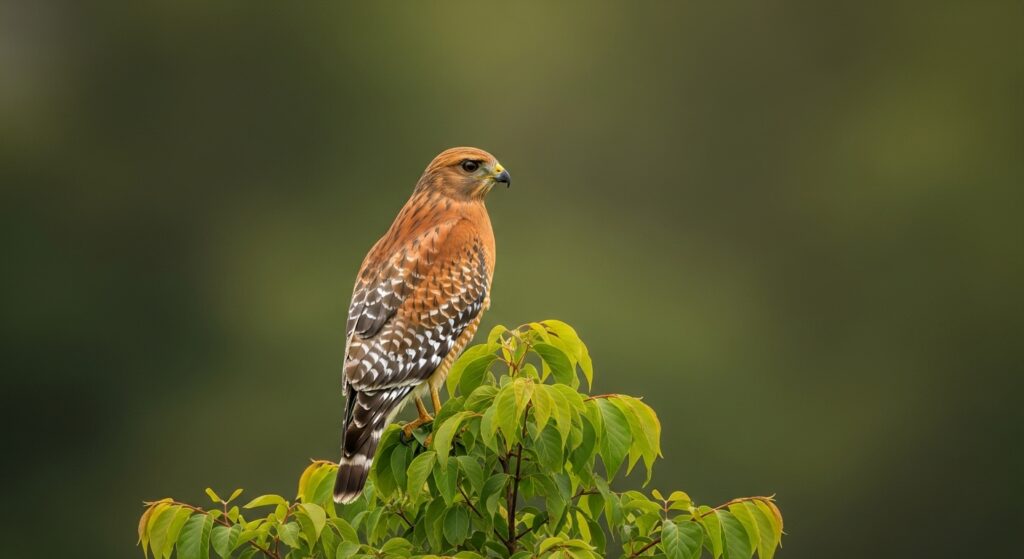
In places such as the Susquehanna River valley, they’re ubiquitous, adding to wetland diversity by regulating prey populations. Their nests, constructed high in mature trees, are safe for their young, with both parents taking turns to feed and guard fledglings.
Exceptionally loud, Red-shouldered Hawks employ their kee-yah calls to broadcast over dense woodland. Well-tolerant in fragmented environments, the species is known to occasionally nest within residential areas when sufficient cover is provided. Diet generalism enables it to capitalize on seasonal prey pulses, such as cicadas at summer emergences.
Conservation activities, for instance, the preservation of wetlands from human development, are crucial since their loss threatens their breeding places. Bird enthusiasts love their fearless visitation, particularly in sanctuaries such as Middle Creek Wildlife Management Area, where their calls reverberate among the trees.
7. Rough-legged Hawk – The Winter Visitor:
- Scientific Name: Buteo lagopus
- Life Span: 10–15 years
- Size: 18–23 in (46–59 cm)
- Weight: 25–49 oz (720–1400 g)
- Wingspan: 52–57 in (132–145 cm)
- Status: Least Concern
- Diet: Small mammals, birds
- Behavior: Hovering flight
- Habitat: Open fields, tundra
Arriving in Pennsylvania every winter, Rough-legged Hawks flee their Arctic breeding habitats. Their feathered legs, an unusual characteristic in hawks, and hovering flight mark them as they sweep fields for voles and mice. Fields surrounding Gettysburg and other open spaces draw in these visitors, where their sharp vision detects prey at a distance. By regulating rodent populations, they play a natural pest control.

Flying thousands of miles from the tundra, Rough-legged Hawks are dependent on PA’s open terrain for hunting. Their speckled coloration, usually dark or light morphs, is well camouflaged to blend with white fields, facilitating stealth.
In contrast to resident hawks, they never nest in PA but instead return north in the spring. Their hovering, kite-like flight helps them save energy while hunting, a treat for birders such as at Pennsylvania Dutch Country. Preserving their open habitats from urbanization means their wintering haven is protected.
8. Northern Goshawk – The Forest Phantom:
- Scientific Name: Accipiter gentilis
- Life Span: 11–15 years
- Size: 20–26 in (50–66 cm)
- Weight: 22–48 oz (630–1360 g)
- Wingspan: 38–46 in (96–117 cm)
- Status: Least Concern
- Diet: Birds, small mammals
- Behavior: Aggressive, secretive
- Habitat: Mature forests
Eluding casual observers, Northern Goshawks haunt Pennsylvania’s deep forests. Their slate-gray plumage and piercing red eyes intimidate prey like birds and squirrels, which they pursue with powerful dives. Preferring mature forests, such as those in the Allegheny National Forest, they remain a rare sighting due to their secretive nature. Their predation controls prey populations.
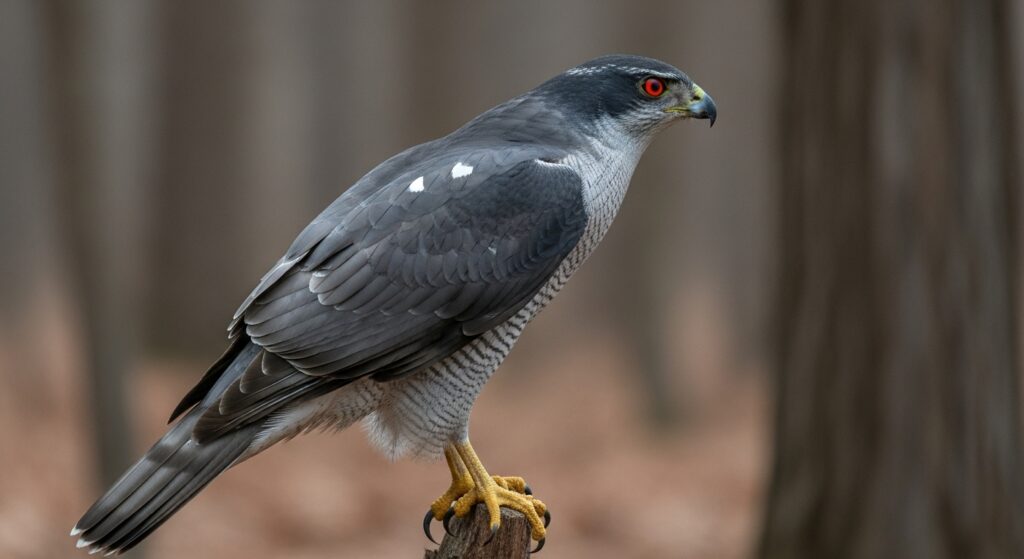
Fiercely territorial, Northern Goshawks defend their domains with aggressive displays, sometimes attacking intruders. Their short wings and long tails enable agile maneuvers through dense timber, making them formidable hunters.
In PA, they favor unbroken woodlands, where prey like grouse and hares abound. Habitat fragmentation poses a threat, as they require expansive forests. Conservation efforts, like those in state forests, protect these habitats, ensuring the goshawk’s elusive presence endures for dedicated birders seeking a glimpse.
9. Swainson’s Hawk – The Rare Migrant:
- Scientific Name: Buteo swainsoni
- Life Span: 10–15 years
- Size: 19–22 in (48–56 cm)
- Weight: 24–48 oz (693–1367 g)
- Wingspan: 47–55 in (119–140 cm)
- Status: Least Concern
- Diet: Insects, small mammals
- Behavior: Social during migration
- Habitat: Grasslands, farmlands
Seldom seen in Pennsylvania, Swainson’s Hawks pass through during their epic migrations. Their long, pointed wings and slender bodies aid journeys from North American grasslands to South America. Stopping in PA’s open fields, they feed on insects and rodents.
Their rarity makes sightings thrilling, often reported at migration hubs like Hawk Mountain Sanctuary. Their social behavior during migration, forming loose flocks, adds to the spectacle of their brief visits.

Embarking on one of the longest migrations among hawks, Swainson’s Hawks travel up to 14,000 miles round-trip. Moreover, In PA, they favor farmlands and prairies, where grasshoppers and voles are plentiful. Their light or dark morphs vary, with lighter birds more common in the East.
Swainson’s Hawks, in contrast to other hawks, are quite gregarious during migration and move in groups, which makes them simpler to locate. It’s important to protect stopover habitats like farmlands since development puts pressure on these areas. So, Birdwatchers love for these few moments when they see hawks, which are a must-see because they fly so gracefully and are so scarce.
10. Ferruginous Hawk – The Occasional Wanderer:
- Scientific Name: Buteo regalis
- Life Span: 12–20 years
- Size: 22–27 in (56–69 cm)
- Weight: 34–73 oz (980–2070 g)
- Wingspan: 52–60 in (133–152 cm)
- Status: Least Concern
- Diet: Small mammals, birds
- Behavior: Solitary, soaring
- Habitat: Open plains, grasslands
Ferruginous Hawks don’t often show up in Pennsylvania; they like western grasslands but may go east. They are easy to spot since they are enormous and have light-colored feathers. They fly high over fields in the country and chase rabbits and ground squirrels with powerful dives. They may be observed in Pennsylvania while they are migrating or in very cold weather. They will also go into open areas like Lancaster County.
When their western habitats become unsuitable, Ferruginous Hawks turn to Pennsylvania’s pastures for hunting grounds. Notably, their large wings and light, buoyant flight style make them well-suited for extended journeys, as they conserve energy while searching for prey. Moreover, these unsocial migrants travel alone, which enhances their enigmatic allure.
Hence, Agriculture is destroying their habitat, which puts their main range at risk. Birders at sites like Blue Mountain become excited when they see these giants in the sky, which happens just a few times a year, generally in late October. For real, their rare appearances at spots like Blue Mountain bring a wild, Western vibe to Pennsylvania’s skies, thrilling birdwatchers with every sighting.
Why Are Hawks Crucial to PA’s Ecosystems?
Hawks are vital to Pennsylvania’s ecosystems because they regulate prey populations, supporting biodiversity and agricultural health. By preying on rodents, insects, and small birds, species like Red-tailed and Broad-winged Hawks prevent overgrazing and pest outbreaks.
Their existence plainly shows that the habitats are strong, as they need a lot of food and clean places to live. For instance, Hawks in Pennsylvania always keep the environment in balance, which means that marshes, woods and fields all around the state stay healthy. Thereby, they keep voles under control on farms and songbirds in balance in forests.
Where can you spot Hawks in Pennsylvania?
All year long, Pennsylvania’s varied landscapes provide excellent chances to see hawks. Indeed, the state is a raptor’s paradise due to its combination of mountains, marshes, and woods. Top locations, such as Hawk Mountain Sanctuary and the wetlands in Erie County, for instance, are home to species like Broad-winged Hawks and Northern Harriers. Because every site offers different, species-specific viewing experiences, it is best to come at peak periods, like as sunrise or fall migrations, to maximise sightings.
Hawk Mountain Sanctuary:
Hawk Mountain Sanctuary is a must-see for hawk lovers, particularly during the autumn migration (September to November). It is located along the Kittatinny Ridge in Berks and Schuylkill Counties. Moreover, The sanctuary’s lookouts, like the North Lookout, provide clear vistas over kilometres of undulating hills, which makes them great places for photography and observation.
Also, Hawk Mountain’s efforts to maintain habitats and study migration are also important for keeping hawk populations healthy. For a whole day of amazing hawk-watching, bring binoculars and a comfortable chair.
Blue Mountain (Bake Oven Knob):
Bake Oven Knob, which located atop Blue Mountain in Lehigh County, is a great place to see hawks, particularly during the autumn migration. For example, you may see Cooper’s Hawks darting through trees like ninjas, their slate-gray backs blending in with the forest. Red-shouldered Hawks also come by. Their booming ‘kee-yah’ cries and rust-red shoulders stand out against the fall leaves. You could even see a Ferruginous Hawk once in a while.
Their big, light-colored bodies stick out when they fly over broad spaces. The route to Bake Oven Knob is not too hard, but the views from the overlook are worth it. The wide space is great for following hawks, and the autumn colours provide a beautiful background.
Waggoner’s Gap (close to Carlisle):
Waggoner’s Gap is another great place for animals to migrate over the Appalachian ridges, just outside of Carlisle in Cumberland County. You may see Cooper’s Hawks here, which fly through the woods in a stealthy, quick way, and Red-shouldered Hawks, whose cries can be heard throughout the valley. The high ridge is a great place to see things, particularly in the fall when migration is in full flow.
The rocky outcrops in the gap are great places for hawks that live in the woods to perch and study the sky. Also, the location is calmer than Hawk Mountain, which makes it a great place to concentrate on birdwatching. The best time to go is in early October, when the activity is at its height.
Philadelphia’s John Heinz National Wildlife Refuge:
The John Heinz National Wildlife Refuge is a year-round hotspot for Northern Harriers right in the middle of Philly. It’s a game-changer for birdwatchers in the city. These hawks are a complete feeling as they hunt over the marshes. They have white patches on their rumps and fly low and smoothly. Their owl-like facial discs help them hear better as they hunt voles and small birds.
The blend of city and nature is cool, with skyscrapers in the background and hawks in the front. Bring a scope if you have one, since the marshes are big and Harriers may cover a lot of land. You may go any time of year, but winter is the best time to see how they hunt.
Middle Creek Wildlife Management Area:
Middle Creek Wildlife Management Area is a great place for hawks to live, particularly in the winter. It located in Lancaster and Lebanon Counties. Rough-legged Hawks are the stars of the show here. Their feathered legs and speckled plumage (light or dark morphs) stand out against the snow-covered ground.
For example, the observation platforms of the tourist centre are great for seeing Rough-legged Hawks’ kites hovering around January or February. Also, Middle Creek’s conservation efforts help keep these places safe from development. For the greatest sightings, go on the trails early in the day. Use a field guide to tell the difference between similar species like Red-tailed Hawks.
The Allegheny National Forest:
Allegheny National Forest lies in the northwest part of Pennsylvania. It’s a real adventure to try to catch the rare Northern Goshawk there. These woodland ghosts are quite secretive, with slate-gray feathers and piercing crimson eyes. Seeing one is a real treat. They go for birds and squirrels by diving through thick trees in a very violent way.
Like the woods near Kinzua Dam, the forest’s large, old forests are the ideal place for these shy hawks to live. The Morrison Trail, for example, gets you deep into the forest, but you’ll need to be patient and lucky to see a Goshawk. Hence, Spring and early summer are the greatest times since that’s when they are most active during breeding season.
Farmlands in Lancaster County:
Lancaster County’s vast farmlands attract uncommon hawks, and they are really a birdwatcher’s paradise for open-country birds. Swainson’s Hawks, which have long, pointed wings, come through during migration, particularly in the autumn. Ferruginous Hawks, which are among of the largest raptors, can turn up in late autumn or during hard winters.
Their huge, light-colored bodies give them immediately as they fly over fields looking for rabbits and ground squirrels. For example, the regions near Strasburg or New Holland provide wide-open vistas that are great for looking through binoculars. Therefore, the patchwork of fields and hedgerows provide enough of food for these travellers.
Pymatuning Reservoir and Erie County:
Northern Harriers may live in Erie County and Pymatuning Reservoir in northwest Pennsylvania all year long. The marshes there are quite special, that’s for sure. These hawks, for example, fly low over the marshes, their white rumps flashing as they hunt meadow voles and sparrows with their sharp hearing.
In the end, The grassy marshes and pathways near the reservoir, like those at Pymatuning State Park, are also great places to see Harriers. These birds are most active at dawn or dusk, therefore these are the best times to see them.
FAQs:
What is the most common hawk in PA?
The Red-tailed Hawk is Pennsylvania’s most common hawk. You’ll often spot it soaring over fields or perched on roadside poles.
What does it mean when a hawk hangs around your yard?
A hawk in your yard is likely hunting small birds or rodents drawn to feeders. It signals a thriving local ecosystem with abundant prey.
Did I see a hawk or a falcon?
Hawks, like Red-tailed Hawks, have broad wings and soar, while falcons, like Peregrine Falcons, have pointed wings and fly fast. Compare size and flight style to identify them.
What attracts hawks to your yard?
Bird feeders, small mammals, and open spaces attract hawks. Tall trees or poles provide perches for hunting.
Final Thoughts:
Hawks in Pennsylvania are ecological heroes. From the Red-tailed Hawk’s rodent control to the Broad-winged Hawk’s migratory displays, each species enriches the state.
So, By supporting conservation and creating hawk-friendly spaces, we ensure their survival. Let’s celebrate and protect these soaring guardians of PA’s ecosystems.
